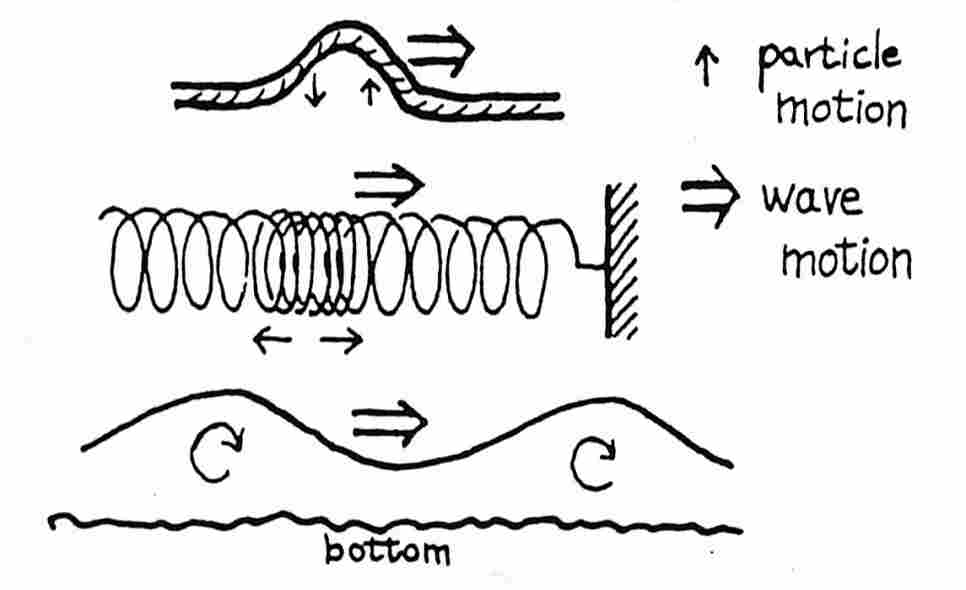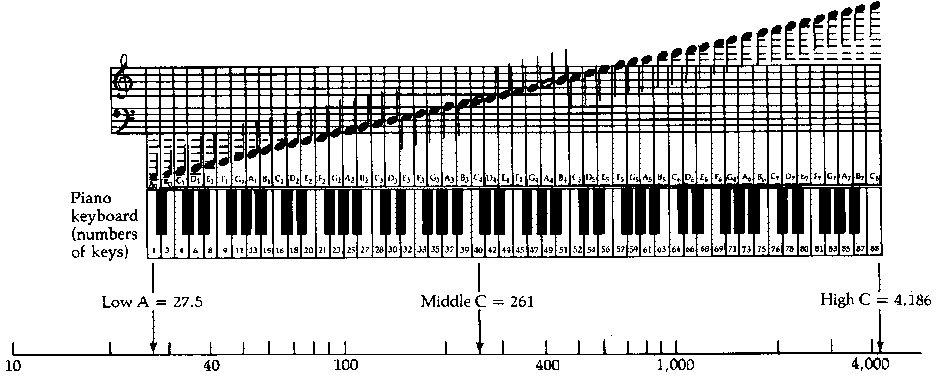INTRODUCTION TO ACOUSTICS: WAVES AND SOUND
R. Port
Jan 27, 2000
For a good introduction
to basic acoustics and hearing, see the McGill Univ audition site.
In particular, read their page Basic
Acoustics and Psychoacoustics, which is similar in content to the
page below.
1. WAVE MOTION: vibration (oscillation) of particles in a medium
A. the acoustic medium must contain particles that
are elastic, that is, sloshy or springlike.
B. The motion of each particle sets adjacent particles in
motion. Energy is transferred over great distances by small local
motions of particles.
C. Types of waves: Differences in motion of particles with
respect to motion of the wave front. All exhibit the same abstract
properties.
1. Transverse. Particles move perpendicular 
to wave front. Like a wave in a rope or slinky.
2. Longitudinal. Particles move forward/backward re wave front.
Like sound (or slinky).
3. Combination waves. Both horizontal and perpendicular motion.
Like familiar surface waves on water.
4. Varying number of dimensions for the medium:
1D (on a line, like rope or wire), 2D (on
a surface, like ripples on pond), 3D (in a volume, like
sound in air, earthquakes in the planet). The behavior of the waves is
fundamentally the same for all of these, despite the differences.
2. WAVE CYCLE AND GRAPH
When air (for example) is still, it has some pressure that is
measurable with a barometer but not detectible by human sensory
systems. For the study of sound, this pressure is considered to be
zero. If something disturbs the air, it typically results in the cyclic
changes in the pressure around this zero which our ears are
sensitive to.
A. Period (T) of a wave is duration between any
point  on a wave
and the same point on the next cycle. Measured in milliseconds for
audible sounds. T = 1/f. Notice there is as much negative
portion as positive portion of a wave (so that the mean is the
pressure of still air (or whatever).
on a wave
and the same point on the next cycle. Measured in milliseconds for
audible sounds. T = 1/f. Notice there is as much negative
portion as positive portion of a wave (so that the mean is the
pressure of still air (or whatever).
B. Frequency (f) is the number of cycles per second. f
= 1/T. Often it is measured in thousands of Hz = kHz (at least
in the auditory range).
C. Amplitude (A) of a wave, the instantaneous pressure
or displacement of particles in the medium. The amplitude has
no relation to wave speed or its frequency. A given sound with greater
amplitude sounds louder than the same sound with smaller amplitude.
D. Velocity of wave front motion (s) depends
solely on the medium. Thus it is independent of A, T
or f. Waves of any frequency move at the same very low
velocity in a slinky but faster in air and faster still in water and
steel.
3. Sound is wave motion, typically of air, in the (humanly
audible) frequency range of 20 Hz--20 kHz. The figure below of a piano
keyboard and the musical gamut shows at least the range of musical
sounds. You can see that the musical scale is logarithmic and that the
highest note on a piano is about 4kHz (still over 2 octaves below the
highest frequency we can hear). The lowest note (at 27.5 Hz) comes
close the lower limit of hearing. The fundamental frequencies of adult
human speech normally lie between about 75 Hz and 400-500 Hz.

4. WAVEFRONT MOTION
A. Propagation. Waves keep on going once initiated. However, in
2D or 3D media, their amplitudes get smaller as they spread since the
energy gets distributed over greater and greater distances.
B. Diffraction. Waves bend around corners. But low frequencies
bend better than high frequencies. Thus in the middle panel below, only
low frequencies will spread like those shown. As frequencies get
higher, the tend to beam straight ahead and not spread to the right and
left.

C. Reflection. Waves reflect partially when resistance of
medium increases.
D. Additivity (or superposition). When several waves are in the
same place at the same time, they just add to each other at each
moment in time. Since (+4) plus a (-4) = 0, it is possible for two
sounds to add up to no sound at all - as long as they always
have the opposite amplitudes at some single location.
5. SOME WAVE TYPES
A. Pure tone or `simple sound.' The wave looks like a `sinusoid'
curve. (See the second figure above.) It is the simplest possible
wave shape - mathematically, the projection of fixed-rate circular
motion onto a perpendicular plane.
B. Complex waves: the sum of two or more sinusoids, usually
harmonically related (that is, integer multiples of a `fundamental
frequency', the f0).
1. harmonic sounds: They sound like a hum or buzz, they have a
clear pitch.
2. nonperiodic sounds: eg, nonharmonic tones (eg, bell which
seems to have several different pitches) and noise (hiss or whoosh)
3. fundamental frequency - the lowest frequency component of a
complex wave. It has this name both because this frequency `generates'
all the others and because typically this is the auditorily heard pitch
of a complex tone.
C. Fourier's Theorem: "Any wave that is periodic can
be represented as the sum of sinusoidal components whose
frequencies are integer multiples of the fundamental period with
appropriately chosen amplitudes. "
D. Spectrum Display: a graph showing the sinusoidal components
that are summed to equal some sound wave.
6. SOUND SPECTRA and ANALYSIS FILTERS
A. Filters. Since sound is always a sum of independent frequency
components, specific frequencies can be added to OR subtracted from any
sound. Various mechanical and electronic devices, called acoustic
filters, can strengthen or weaken selected frequencies relative to
other frequencies. Many things can be acoustic filters, for example, a
physical tube, a room, a loudspeaker, a microphone, etc.
B. A Sound Spectrogram is a graphic display of the sinusoidal
components of a sound. These displays are very useful for understanding
speech sounds.
For more on speech spectra, check Port's speech acoustics page and the speech
web references on the syllabus page.

 on a wave
and the same point on the next cycle. Measured in milliseconds for
audible sounds. T = 1/f. Notice there is as much negative
portion as positive portion of a wave (so that the mean is the
pressure of still air (or whatever).
on a wave
and the same point on the next cycle. Measured in milliseconds for
audible sounds. T = 1/f. Notice there is as much negative
portion as positive portion of a wave (so that the mean is the
pressure of still air (or whatever).
